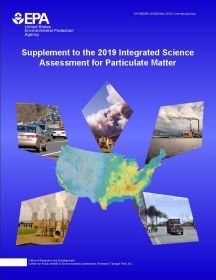Integrated Science Assessment (ISA) for Particulate Matter
On this page:
The Issue
Particulate matter (PM) is a complex mixture of small particles and liquid droplets found in the air. Particulate matter is of great concern because it is associated with serious health effects such as nonfatal heart attacks, irregular heartbeat, aggravated asthma, decreased lung function, and premature death. PM contributes to haze, damages materials including, stone, glass, and metals, and affects the climate, both through direct effects on radiative forcing and indirect effects involving cloud processes.
EPA Action
EPA scientists are evaluating the latest scientific information to better understand the relationship between exposure to particulate matter and health and welfare effects, who may be at increased risk to these effects, how particles form in the atmosphere, and what the contributions are from various sources in different regions of the country.
The Clean Air Act requires EPA to periodically review the science for six major air pollutants, including PM. EPA's Center for Public Health and Environmental Assessment (CPHEA) develops Integrated Science Assessments (ISAs) that summarize the science related to the health and welfare effects of these pollutants. ISAs provide a comprehensive review of the policy-relevant scientific literature published since the last National Ambient Air Quality Standards (NAAQS) review and are a critical part of the scientific basis for updating the NAAQS. This ISA represents EPA’s latest evaluation of the scientific literature on the potential health and welfare effects associated with PM and updates the 2009 Integrated Science Assessment for Particulate Matter. A May 2022 update, referred to as the Supplement to the 2019 Integrated Science Assessment for Particulate Matter, represents a targeted assessment of scientific information published since the literature cut-off date of the Integrated Science Assessment for Particulate Matter (Final, 2019). Together the 2019 ISA and the Supplement form the complete scientific record for the reconsideration of the 2020 PM NAAQS.
- Learn about the Integrated Science Assessment for Particulate Matter (2019)
- Learn about the Supplement to the 2019 Integrated Science Assessment for Particulate Matter
- Learn about the Particulate Matter Air Quality Standards
History of the Particulate Matter Assessments
Peer Reviewed Literature
While working on the Supplement to the 2019 Integrated Science Assessment for Particulate Matter (2022), EPA used the Health and Environmental Research Online (HERO) database to augment the underlying literature that supported the draft assessment.
See: ISA-Particulate Matter (2021) HERO Project page
HERO is a searchable database of more than 1.6 million scientific studies and other references used to develop EPA assessments aimed at understanding the health and environmental effects of pollutants and chemicals.
Get the Report

Supplement to the 2019 ISA PM (2022)
(PDF, 328 pp, 6.7MB)
ISA PM (2019)
(PDF, 1967 pp, 40 MB)

